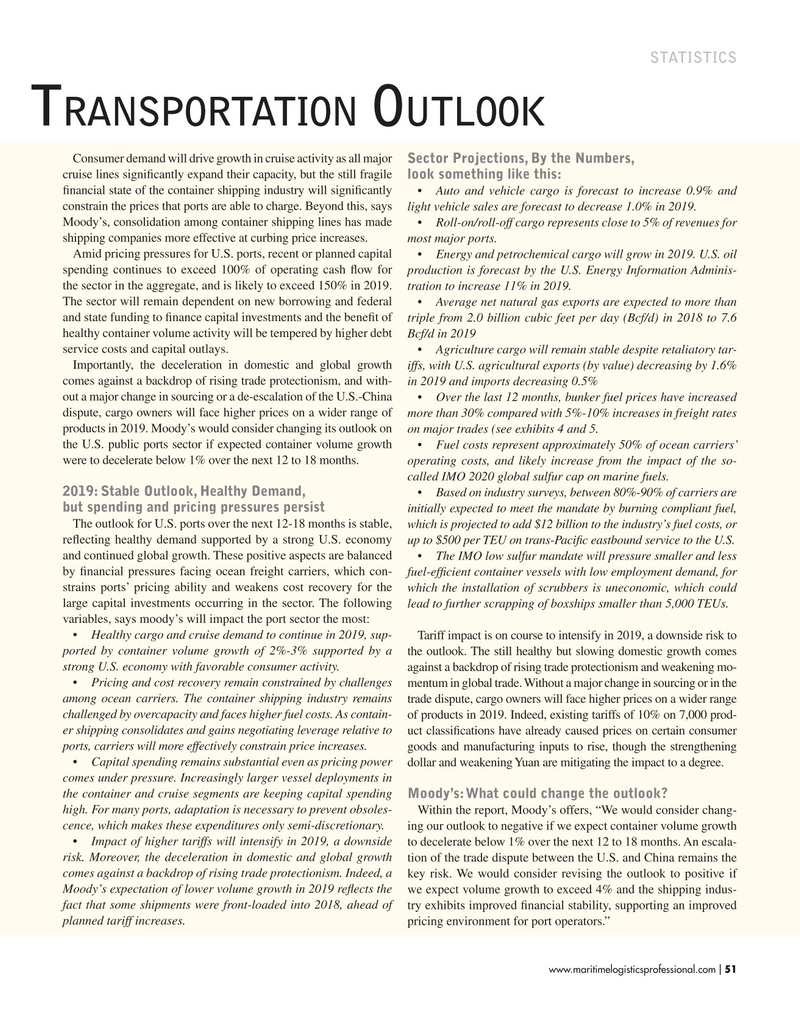
Page 51: of Maritime Logistics Professional Magazine (Nov/Dec 2018)
Regulatory & Environmental Review
Read this page in Pdf, Flash or Html5 edition of Nov/Dec 2018 Maritime Logistics Professional Magazine
STATISTICS t oransPortation utLook
Consumer demand will drive growth in cruise activity as all major
Sector Projections, By the Numbers, cruise lines signifcantly expand their capacity, but the still fragile look something like this: fnancial state of the container shipping industry will signifcantly • Auto and vehicle cargo is forecast to increase 0.9% and constrain the prices that ports are able to charge. Beyond this, says light vehicle sales are forecast to decrease 1.0% in 2019.
Moody’s, consolidation among container shipping lines has made • Roll-on/roll-off cargo represents close to 5% of revenues for shipping companies more effective at curbing price increases. most major ports.
Amid pricing pressures for U.S. ports, recent or planned capital • Energy and petrochemical cargo will grow in 2019. U.S. oil spending continues to exceed 100% of operating cash fow for production is forecast by the U.S. Energy Information Adminis- the sector in the aggregate, and is likely to exceed 150% in 2019. tration to increase 11% in 2019.
The sector will remain dependent on new borrowing and federal • Average net natural gas exports are expected to more than and state funding to fnance capital investments and the beneft of triple from 2.0 billion cubic feet per day (Bcf/d) in 2018 to 7.6 healthy container volume activity will be tempered by higher debt Bcf/d in 2019 service costs and capital outlays. • Agriculture cargo will remain stable despite retaliatory tar-
Importantly, the deceleration in domestic and global growth iffs, with U.S. agricultural exports (by value) decreasing by 1.6% comes against a backdrop of rising trade protectionism, and with- in 2019 and imports decreasing 0.5% out a major change in sourcing or a de-escalation of the U.S.-China • Over the last 12 months, bunker fuel prices have increased dispute, cargo owners will face higher prices on a wider range of more than 30% compared with 5%-10% increases in freight rates products in 2019. Moody’s would consider changing its outlook on on major trades (see exhibits 4 and 5.
the U.S. public ports sector if expected container volume growth • Fuel costs represent approximately 50% of ocean carriers’ were to decelerate below 1% over the next 12 to 18 months. operating costs, and likely increase from the impact of the so- called IMO 2020 global sulfur cap on marine fuels. 2019: Stable Outlook, Healthy Demand, • Based on industry surveys, between 80%-90% of carriers are but spending and pricing pressures persist initially expected to meet the mandate by burning compliant fuel,
The outlook for U.S. ports over the next 12-18 months is stable, which is projected to add $12 billion to the industry’s fuel costs, or refecting healthy demand supported by a strong U.S. economy up to $500 per TEU on trans-Pacifc eastbound service to the U.S.
and continued global growth. These positive aspects are balanced • The IMO low sulfur mandate will pressure smaller and less by fnancial pressures facing ocean freight carriers, which con- fuel-effcient container vessels with low employment demand, for strains ports’ pricing ability and weakens cost recovery for the which the installation of scrubbers is uneconomic, which could large capital investments occurring in the sector. The following lead to further scrapping of boxships smaller than 5,000 TEUs.
variables, says moody’s will impact the port sector the most: • Healthy cargo and cruise demand to continue in 2019, sup- Tariff impact is on course to intensify in 2019, a downside risk to ported by container volume growth of 2%-3% supported by a the outlook. The still healthy but slowing domestic growth comes strong U.S. economy with favorable consumer activity. against a backdrop of rising trade protectionism and weakening mo- • Pricing and cost recovery remain constrained by challenges mentum in global trade. Without a major change in sourcing or in the among ocean carriers. The container shipping industry remains trade dispute, cargo owners will face higher prices on a wider range challenged by overcapacity and faces higher fuel costs. As contain- of products in 2019. Indeed, existing tariffs of 10% on 7,000 prod- er shipping consolidates and gains negotiating leverage relative to uct classifcations have already caused prices on certain consumer ports, carriers will more effectively constrain price increases. goods and manufacturing inputs to rise, though the strengthening • Capital spending remains substantial even as pricing power dollar and weakening Yuan are mitigating the impact to a degree.
comes under pressure. Increasingly larger vessel deployments in the container and cruise segments are keeping capital spending
Moody’s: What could change the outlook?
high. For many ports, adaptation is necessary to prevent obsoles- Within the report, Moody’s offers, “We would consider chang- cence, which makes these expenditures only semi-discretionary. ing our outlook to negative if we expect container volume growth • Impact of higher tariffs will intensify in 2019, a downside to decelerate below 1% over the next 12 to 18 months. An escala- risk. Moreover, the deceleration in domestic and global growth tion of the trade dispute between the U.S. and China remains the comes against a backdrop of rising trade protectionism. Indeed, a key risk. We would consider revising the outlook to positive if
Moody’s expectation of lower volume growth in 2019 refects the we expect volume growth to exceed 4% and the shipping indus- fact that some shipments were front-loaded into 2018, ahead of try exhibits improved fnancial stability, supporting an improved planned tariff increases. pricing environment for port operators.” www.maritimelogisticsprofessional.com 51
I

 50
50

 52
52
